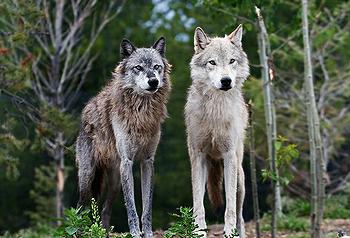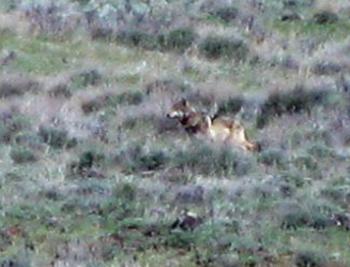 美國有一些對野狼不好的消息:聯邦魚類暨野生動物局拒絕了一份保育團體的請願書,不願將瀕危的墨西哥灰狼(Mexican gray wolf)從灰狼之保育政策中獨立出來。懷俄明州獵人有新的許可證,可以見狼就殺;華盛頓州的政府官員也在公共土地上殺了一整群狼。
美國有一些對野狼不好的消息:聯邦魚類暨野生動物局拒絕了一份保育團體的請願書,不願將瀕危的墨西哥灰狼(Mexican gray wolf)從灰狼之保育政策中獨立出來。懷俄明州獵人有新的許可證,可以見狼就殺;華盛頓州的政府官員也在公共土地上殺了一整群狼。
墨西哥灰狼保育議題遭到駁回
美國魚類和野生動物局5日宣布,墨西哥狼(Mexican wolf,Canis lupus baileyi)目前並不需要從「瀕危物種法」(Endangered Species Act)中獨立列出,仍是和現存灰狼(gray wolves,Canis lupus)同樣繼續受到聯邦現有制度保護。
該局沒有提出任何理由說明該項決定,只表示墨西哥狼的復育工作已在規劃中,預計2013年公佈並進行學術審查。
雖然野外現存只有不到60隻的墨西哥狼,及上個月底美國公職人員環境責任協會(Public Employees for Environmental Responsibility, PEER)的正式投訴,但當局仍不想釋放更多的復育個體。美國公職人員環境責任協會質疑當局的調查結果與說法,並認為其忽視其他團體的投訴乃是政治操作涉及墨西哥狼保育議題的作為。
在多年復育工作成效不佳後,美國魚類暨野生動物局自2010年開始一個新的墨西哥狼的復育計畫。而美國公職人員環境責任協會根據內政部新的「科研誠信法規」(scientific integrity rules)於今年6月提出申訴,描述科學家們因為該新計畫而削弱或竄改科研結果。
內政部沒有像投訴書中所希望的,讓外界人士來進行評估,而是要求魚類暨野生動物局自己進行檢討。調查工作由魚類暨野生動物局的職員Richard Coleman進行。他在9月25日回信駁斥了那些投訴,但卻沒有實質的證據。
獵人瞄準懷俄明州的狼群
 懷俄明州針對現存328頭狼的狩獵季節於10月開始。現在,狼在全州地區幾乎都可以被合法射殺或誘捕,用氣體燻狼窩、殺死幼狼,以及藉口殺狼而誘使人狼衝突的發生,都是合法的。
懷俄明州針對現存328頭狼的狩獵季節於10月開始。現在,狼在全州地區幾乎都可以被合法射殺或誘捕,用氣體燻狼窩、殺死幼狼,以及藉口殺狼而誘使人狼衝突的發生,都是合法的。
當美國魚類暨野生動物局決定從聯邦瀕危物種名單中刪除狼,並改變懷俄明州對狼隻的管理政策後,新政策即於9月30日生效。
美國魚類暨野生動物局表示,懷俄明州的灰狼數量已經回升,不需要處於「瀕危物種法」的保護之下。
而另一場戰鬥正在法院進行中。9月10日起,「地球正義」(Earthjustice)擔任保育團體聯盟代表60天,針對聯邦政府取消對懷俄明州狼隻的保護,提交訴訟至法院。
華盛頓州政府殺了狼群
在幾經爭論後,華盛頓州魚類和野生動物局(Washington Department of Fish and Wildlife, WDFW)於9月27日宣布,一個受雇槍手在華盛頓州東北部加拿大邊境處殺害了Wedge狼群的領頭狼(Alpha male)。
該局主任Phil Anderson表示,狼是被從直升機上射殺的。領頭狼的死亡使該群的六頭狼在過去三天離開Wedge狼群,包括頭號母狼(Alpha female)。
該局開始獵殺Wedge狼群,以避免狼群持續攻擊史蒂文斯縣(Stevens County)北部Diamond M 牧場牲口的事件。Anderson表示,七月以來,狼群已經殺死或傷害至少17頭母牛或小牛。
Diamond M 牧場的牛隻在公共土地上吃草;然而,保育人士表示,狼群比這些牲口更有資格在這些公共土地上活動。
 孤獨的加州狼群可得到州政府保護
孤獨的加州狼群可得到州政府保護
加州魚類和野生動物狩獵委員會(California Fish and Game Commission)在10月3日一致投票通過,使灰狼成為該州「瀕危物種法」保護下的一員。
當加州魚類和野生動物狩獵署認定該州狼群是需要長期保護時,便會將其納入該州「瀕危物種法」的名單中。該部門將進行為期一年的「狀態審查(status review)」,以決定是否要給加州狼群更長久的保護。
這項決定將做為今年早些時候由「生物多樣性中心」與其他保育團體所提出請願書的回應,該請願書認為,要在西海岸建立合適狼群復育工作的棲息地,加州將是至關重要的地區。
The U.S. Fish and Wildlife Service has rejected a petition by conservation groups to list the endangered Mexican gray wolf separately from other gray wolves. Wyoming hunters have new license to kill wolves on sight, and Washington state officials killed a wolf pack on public land.
Mexican Gray Wolf Conservation Concerns Dismissed
U.S. Fish and Wildlife Service Friday announced its determination that the Mexican wolf, Canis lupus baileyi, does not currently warrant separate classification under the Endangered Species Act and will continue to receive federal protection as an endangered species included within the existing species-level listing of gray wolves, Canis lupus.
The Service gave no reason for its determination but said it is in the process of revising and updating the Mexican wolf recovery plan, which is expected to be released for public and peer review in 2013.
Although fewer than 60 Mexican wolves remain in the wild, the release of more is not likely given the response of the Service late last month to a formal complaint from Public Employees for Environmental Responsibility, PEER, which challenged the cogency and accuracy of findings by an agency official who rejected calls for independent reviews of complaints involving political manipulation of science regarding Mexican wolf recovery.
Conceding failure after years of recovery efforts, in 2010, the Service began a new Mexican wolf recovery process. In a complaint filed this June under new Department of Interior scientific integrity rules, PEER detailed how the scientists assembled for this new process were pressured to water down and alter scientific findings.
Instead of bringing in outside reviewers as it has for other complaints, officials at the Department of the Interior asked the Service to review itself. The investigation was handed to an FWS career official, Richard Coleman. In his September 25 reply letter, Coleman dismissed all the complaint specifications, giving no evidence for his defense.
Hunters Take Aim at Wyoming Wolves
In Wyoming, hunting season for the state’s remaining 328 wolves began October 1. Wolves can now be shot on sight and trapped throughout most of the state. It is legal to gas wolf dens, kill wolf pups, and bait wolves into conflicts as a pretext for wolf killing.
The new policy began September 30 when the Fish and Wildlife Service’s decision that removed wolves from the federal Endangered Species List and turned over wolf management in Wyoming to state officials took effect.
The Service says the Wyoming population of gray wolves is recovered and no longer warrants protection under the Endangered Species Act.
But another court battle is in the works. On September 10, a coalition of conservation groups, represented by Earthjustice, served 60-day notice that it will file a court challenge to the federal government’s removal of Endangered Species Act protections for Wyoming wolves.
Washington State Kills Wedge Wolf Pack
After much controversy, on September 27, the Washington Department of Fish and Wildlife announced that an agency marksman had killed the Wedge Pack’s alpha male just south of the Canadian border in northeastern Washington.
WDFW Director Phil Anderson said the wolf was shot from a helicopter. Its death brought to six the number of wolves from the Wedge Pack removed in the preceding three days, including the alpha female.
The department initiated removal of the Wedge Pack to stop what Anderson called “its persistent attacks on livestock from the herd of the Diamond M Ranch in northern Stevens County.” Since July, the wolves had killed or injured at least 17 calves and cows from the herd, he said.
The Diamond M cattle were grazing on public land; conservationists say wolves have greater rights on public land than do cattle.
Lone California Wolf Could Get State Protection
On October 3 the California Fish and Game Commission voted unanimously to make the gray wolf a candidate for protection under the state’s Endangered Species Act.
The decision gives wolves immediate protection under California’s Endangered Species Act while the California Department of Fish and Game decides if long-term protections are warranted. The department will do a one-year “status review” of whether to give California wolves more permanent protection.
The decision came in response to a petition earlier this year by the Center for Biological Diversity and other conservation groups who argue that California will be vital to restoring wolves to suitable habitat along the West Coast.
※ 全文及圖片詳見:ENS





